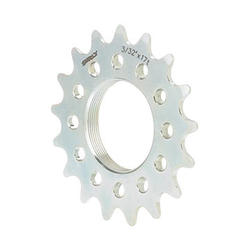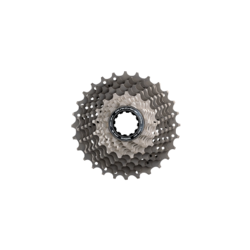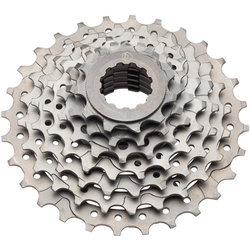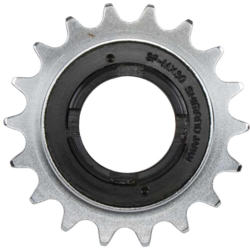Bike Chain Replacement & Maintenance
It’s best to replace your bike chain often to save money!
Even with regular maintenance & lubrication most bicycle chains need to replaced about every 1500 miles, however mountain bikes need bike chain replacement more often due to mud, dirt and other debris speeding up wear. At this point a chain has been stretched and worn to a point where it causes severe damage to the chainrings, cassette or freewheel and pulley wheels of the rear derailleur. All this extra wear and tear can cause you hundreds of dollars in necessary repairs. The good news is there's a simple step you can take to help to keep this from happening!

Chain wear & chain stretch
As you accumulate miles on your bike’s drivetrain components (chain, crank, cassette, derailleurs) your chain begins to stretch & weaken. When you ride you are not only stretching the chain lengthwise but you are also flexing and wearing the chain’s side plates. This weakens the chain’s ability to shift as sharply as it once did as well as increases wear to your cassette, chainrings and derailleur pulley wheels. We have to remember that a bike’s drivetrain is made up of metal and this metal breaks down and wears with increased mileage. A worn chain increases the amount of wear and tear on the other parts of the drivetrain. All the pieces of your drivetrain are meant to smoothly mesh together, once too much wear sets in it becomes much harder to impossible for this synergy to happen. By replacing your chain more frequently you are maximizing the life of the drivetrain of your bike, saving you a bunch of money over time. Are you seeing why more frequent bike chain replacement is a good thing?How do you know if your chain is worn?
One tell tale sign of a worn out chain is a reduced performance in shifting and perhaps an increase in noise, if your chain skips under load (sprinting or climbing) then it’s definitely replacement time! A skipping chain can also result in an injury, get it replaced asap.
How do you measure bike chain wear? Well, there are a 2-3 simple ways to see if your chain is worn or stretched.
The most technical and best way to measure bike chain wear is to measure the chain with a chain measure tool. We suggest using the Park Tool CC-3.2 chain measuring tool. It’s very easy to use and inexpensive.How much does a bike chain cost to replace?
Entry level chains can start off around $15.00 with more expensive and higher performance chains ranging from $25.00 to $60.00 or more. More expensive chains increase shift quality and are generally more durable as they wear. A more expensive chain may be a few grams lighter as well if weight is a concern for you. Most shops charge $15 to $20 to install a chain or you can purchase a chain tool for $10 to $50 and learn to do it yourself. Having a chain tool in your tool box is never a bad idea in any case.
What if you wait too long to replace your chain?
If you wait to replace your chain until you start skipping under load or start snapping your chain then most likely you’ll be looking at minimally replacing your chain as well as your cassette. This is because your cassette & chain are meant to work in harmony, the chain is designed to sit smoothly on the teeth of the cassette. If the cassette becomes too worn it cannot hold the chain any longer because it’s teeth get too worn down. Another bad side effect to waiting too long is that your front chainrings can become “shark toothed”, meaning that cannot hold a chain properly due to too much wear and tear. An easy way to determine this is if you’re able to see daylight between the chain and the teeth of the big chainring when looking at the bike from the geared side.
The cost to replace a cassette or freewheel can range anywhere from $25 to upwards of $300 on high end bikes and chainrings can run anywhere from around $40 to $250 on high end bikes. So replacing your chain often makes even more sense when taking these costs into consideration and these prices don't include labor costs either!
What about chain maintenance?
Simply put, you need to give your chain some love. Just by lubricating and cleaning your chain often you will increase it’s lifespan.
An easy way to do this is to pick out a chain lube that works for you (your bike shop can help you here) and apply the lubricant to your chain every 2-3 rides. You don’t want to over lubricate and you should only use bicycle friendly lubricants, no motor oil here folks & no old school WD-40 (it strips lubricants away) either!
Apply the lubricant to the chain by turning the cranks as you apply the lube liberally, once done continue to turn the cranks a few rotations to allow the lube to sink into the chain. At this point you’ll want to take a clean rag and wipe the excess chain lube off as well as any debris and dirt that has loosened up from the new lubricant. You’ll want to continue to do this until your rag is getting minimal dirt and grime on it, in the real world you’ll never really get it all but do your best. So not only are you lubing the chain but you’re cleaning it too, this is a win-win!
If your chain is excessively dirty you may want to apply a citrus based degreaser to help loosen up the heavy stuff before applying your lube. We suggest using Finish Line Citrus Degreaser as it works well and is 100% biodegradable and is non-toxic. You’ll follow the same steps as applying your chain lube to get the best results, just wait a couple of minutes before wiping your degreaser off to allow it to work it’s magic! If you decide to use a degreaser make sure you apply your lubricant after you’re done cleaning as a chain with no lube will wear out quicker, taking your drivetrain with it.
In conclusion
Now that we’ve gone over when to replace your bike chain and why you should as well as some basic chain maintenance you should be on your way to having a fresher, better working drivetrain!
If you need more help or have any questions please contact us and of course we’re here to help with chain replacement and any other service needs you may have.












